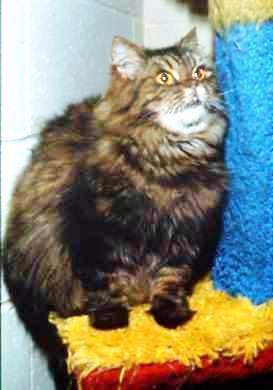8 Ways to Slim A Cat

“I is fluffy…AND fat!”
Is your cat fluffy or fat? Obesity is defined as exceeding ideal body weight by 20 percent, and today about forty percent of cats are considered overweight. Overweight cats tend to carry a “pouch” of fat low in the tummy, but seem of average size otherwise. If you can’t feel the pet’s ribs, and/or she has a pendulous or bulging tummy, your pet is too plump.
I’m fortunate that Seren-kitty has always been petite, a good eater but not overly pudgy. She doesn’t even have that tummy pouch. In her case, she’s always been very active and I think that’s one reason she remains so healthy even at her advancing age.
So if your tabby is tubby, why should you care? Obesity increases risk for diabetes, and is an aggravating factor in heart problems, arthritis, and skin problems.
Common Causes for Fat Felines
Spaying and neutering won’t make kitty fat, but does reduce metabolic rate—how fast and efficiently food is use—by 15 to 20 percent. So unless food intake and exercise are adjusted after surgery, cats can gain weight.
Middle aged and older cats also tend to gain weight. Part of that may be due to changes in aging senses. While feline appetite is stimulated by scent, veterinary experts say a partial reduction in smell sense prompts cat to eat more food.
Indoor-only cats exercise less since they don’t have to chase mice to survive. Couch-potato pets fed high-calorie tasty foods often overeat either out of boredom or from being over-treated by owners.
8 Ways to Slim A Cat
Your vet should rule out potential health complications beforehand. Kitty crash diets can prompt deadly liver problems, called hepatic lipidosis. It’s best to aim for losing only about 1 percent of kitty’s starting weight per week. Medical supervision or a special therapeutic weight-loss diet prescribed by the vet may be necessary for obese cats. But for moderately overweight kitties, these tips work well.
Curb Snacks. Eliminating or reducing treats easily cuts calories. Instead, reserve part of the kitty’s regular diet—a handful of kibble, for instance. Keep it handy to dispense as “treats” when Kitty pesters, or reward with attention, not treats. (Ooooooh I can hear the cats now yowling, “No fair!”
Meal Feed. Rather than keeping the bowl full for all day nibbling, switch to meal feeding measured amounts. Divide the daily food allotment into four or even five small meals keep her from feeling deprived. Multiple small meals increase the body’s metabolic rate, so she burns more calories faster. (Hey, this works for me, too, when I can manage to do it.)
Offer Diet Foods. Reducing diets typically replace fat in the food with indigestible fiber, dilute calories with water, or “puff up” the product with air. “Senior” diets typically have fewer calories, so switching older pets to an age-appropriate formula helps. “Lite” diets aren’t magical and only mean the food has less calories than the same brand’s “regular” food—it might have more calories than another company’s food. Some cats eat more of the diet food to make up for lost calories, so you still have to measure the meals. Be sure to check with your vet before deciding to make major nutrition changes, though.
Go For A Walk. Make twice-daily 20 minute exercise part of your routine. Cats won’t power walk, but a slow to moderate stroll at the end of the leash once or twice a day around the house or garden will help burn energy.
Schedule Play. Interactive play is the best way to encourage feline exercise. Feather toys or fishing-pole lures that the cat will chase are ideal. Some cats learn to play fetch if you toss tiny wads of paper across the room or down the stairs. Entice your cat to chase the beam of a flashlight. Or toss kitty kibble for the cat to pounce and munch.
Create A Hunt. Put food at the top or bottom of the staircase, or on a cat tree so kitty has to get off her pudgy nether regions to eat. If she can’t manage stairs or leaps, put the bowl on a chair and provide a ramp up so he’s burning a few calories. Setting the bowl across the house from Fluffy’s bed also forces her to move.
Puzzle The Cat. Commercial treat balls and interactive feeders are great options. Place one or two meal portions inside kitty puzzles so he must work to get the food. This can solve portion control, exercise, and the pester factor all in one.
Automatic Feeders. When you must be gone during the day, consider using an automatic feeder. Some have refrigerated units to offer fresh canned food servings from locked compartments at timed intervals
How do you handle your pudgy kitty? Does he or she eat a special diet, or do you try to increase exercise in some way? What tricks work for your clowder, please share! Obesity impacts more than looks. It’s also a longevity issue. Overweight cats have an increased risk for dying in middle age. A slim cat enjoys all nine of her lives.
I love hearing from you, so please share comments and questions. Do you have an ASK AMY question you’d like answered? Do you have a new kitten and need answers? Stay up to date on all the latest just subscribe the blog, “like” me on Facebook, listen to the weekly radio show, check out weekly FREE PUPPY CARE newsletter, and sign up for Pet Peeves newsletter. Stay tuned for more news about my forthcoming THRILLER, LOST & FOUND!
Filed under: Cat Behavior & Care Tagged: Amy Shojai, cat behavior, cat diets, cat food, cat training, fat cats, how to slim a cat, www.amyshojai.com




